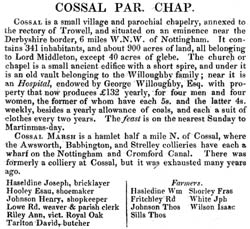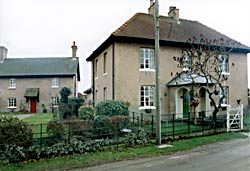
 |
Entry for the "small village and parochial chapelry" of Cossall in William White's History, Gazetteer and Directory of Nottinghamshire, 1832. |
Printed
A comprehensive list of books and articles on the history of Nottinghamshire villages published before 1998 can be found in
- Michael Brook, A Nottinghamshire Bibliography: publications on Nottinghamshire history before 1998, Thoroton Society Record Series, 42, 2002.
For material published since 1997, search the online library catalogues of Nottinghamshire County Council
and the University of Nottingham
Village packs
Nottingham/Nottinghamshire public libraries have produced a useful series of village packs, containing photocopies of key printed sources: extracts from trade directories and guide books, old maps, newspaper articles etc. Search the online library catalogue for the village of interest plus the term "village pack" for further details.
Primary printed sources
Trade directories
Directories are an important historical source for village communities in the 19th and early 20th centuries. They list the principal inhabitants (landowners, farmers, professionals and tradesmen/women), and often provide a basic history of the place and sometimes details of contemporary developments such as the rebuilding of the village.
Leicester University has recently made the full text of a representative selection of trade directories for Nottinghamshire and other counties available online:
Parliamentary enquiries
19th century parliamentary enquiries on operation of the poor law and on agricultural employment can provide an invaluable insight into the lives of villagers during the period. For example, the Reports to the Poor Law Board on the operation of the laws of settlement and removal of the poor presented to both Houses of Parliament in 1850 have been used to explore the influence of institutional factors on the evolution of settlement patterns:
- D R Mills, The geographical effects of the laws of settlement in Nottinghamshire: an analysis of Francis Howell’s report, 1848, East Midland Geographer, 5, 1970.
The Answers to rural queries (Appendix B to the First report on the operation and administration of the Poor Laws) published in 1834 provide a wealth of material on the lives of Nottinghamshire agricultural labourers in the early 19th century:
- J D Marshall, Nottinghamshire labourers in the early nineteenth century, Transactions of the Thoroton Society, 64, 1960
Secondary printed sources
General
- Maurice Beresford, The lost villages of England, Stroud: Sutton, 1988
- Trevor Rowley, Villages in the landscape, Orion, 1994
- Trevor Rowley and John Wood, Deserted Villages, Shire (3rd edition), 2000
- Christopher Taylor, Village and Farmstead. A history of rural settlement in England, George Philip & Son, 1983
- Carenza Lewis, Patrick Mitchell-Fox and Christopher Dyer, Village, hamlet and field. Changing medieval settlements in central England, Macclesfield: Windgatherer Press, 2001
- Brian K Roberts, Rural settlement in Britain, Hutchinson, 1977
- Brian K Roberts, The making of the English village, Longmans, 1987
Nottinghamshire
Approaches to studying village community history are described and the sources illustrated and discussed in:
- Alan Rodgers (ed.) Approaches to Nottingham’s history, University of Nottingham, Department of Adult Education, 1972 (The section, “Nottingham and its villages 1750-1850”, includes a study of Arnold in the 1850s and advice on using parish records and the Census to study the history of Bleasby, Bulcote and Burton Joyce)
- J F Phillips, Town and village in the nineteenth century. Nottingham and Nottinghamshire villages: some lines of enquiry, University of Nottingham, Department of Adult Education, 1972
Estate/model villages
 |
Distinctive cottages, built by the first Earl Manvers c.1807-12, in the model village of Budby. |
There are several good examples of estate villages in the county: i.e., villages re-planned and rebuilt in a uniform fashion by the landowner. Budby, for example, was rebuilt in a distinctive Gothic style by Earl Manvers of Thoresby Hall in the early 19th century; Ossington and Winkburn enjoyed ‘makeovers’ in the mid-19th century, though the style is plainer. A good general introduction to estate villages:
- Gillian Darley, Villages of vision, Palladin, 1986
The village of Whatton, in the Vale of Belvoir, was rebuilt in neo-Elizabethan style in the 1840s:
- Henstock, A. The Halls of Whatton: the faltering rise of a Victorian landed family, Transactions of the Thoroton Society, 86, 1982, pp97-105
Individual villages
W. E. Doubleday (also known as ‘John Granby’) wrote histories of virtually every Nottinghamshire village and published them in the Nottinghamshire Guardian during the 1940s and 1950s. Scrapbooks containing these articles are held at Nottingham Local Studies Library and at the East Midlands Collection based in the Hallward Library, Nottingham University. Doubleday developed an impressive card reference system to support his research; the ‘Doubleday Index’, organised alphabetically (and then for each village by period and theme), contains thousands of references and is accessible at the Local Studies Library at Nottingham Central Library.
Published village histories vary enormously in quality and usefulness. Consult Brook’s Nottinghamshire Bibliography (reference at top of page) for a comprehensive list of histories published before 1998. One of the most scholarly yet accessible village histories is
- J V Beckett, A history of Laxton. England’s last open field village, Oxford: Basil Blackwell, 1989
Deserted settlements in Nottinghamshire
- Alan Cameron, The deserted medieval village of Thorpe-in-the-Glebe, Nottinghamshire, Transactions of the Thoroton Society, 85, 1981
- Alan Cameron, Meering and the Meryng family, Transactions of the Thorton Society of Nottinghamshire, 77, 1973
- Alan Cameron, The deserted medieval village of Sutton Passeys, Transactions of the Thoroton Society, 80, 1976
- Alan Cameron, Enclosure and the depopulation of Stanton-on-the-Wolds, in J Becket (ed.), Nottinghamshire past. Essays in honour of Adrian Henstock, Merton Priory Press for Nottinghamshire County Council, 2003
- Glynn Coppack, The deserted medieval village of Keighton, Transactions of the Thoroton Society, 75, 1971
- Lloyd Laing, Excavations on the deserted medieval settlement of Keighton, Nottinghamshire, 2000-01, Transactions of the Thoroton Society, 105, 2001
Settlement patterns and plans
- Keith Challis, Settlement morphology and medieval village planning: a case study at Laxton, Nottinghamshire, Transactions of the Thoroton Society, 106, 2002
- I B Terrett, Nottinghamshire, in H C Darby and I S Maxwell (eds.), The Domesday geography of Northern England, Cambridge University Press, 1962, pp236-242
- Colm F O’Brien, Land and settlement in Nottinghamshire and lowland Derbyshire. An archaeological review, East Midlands Archaeological Bulletin, 12 (Supplement, 1978)
Village communities
- Kate Holland (ed.) Mender of disorders: court and community in the Archdeaconry of Nottingham, 1560-1756, University of Nottingham, Manuscripts and Special Collections, 2004